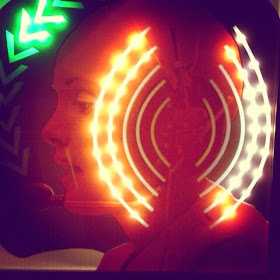by Beatrice Jeschek
 |
| #BIGDATAART #MUNICH by David Blitz |
Why we need to trust big data opening a door to an individual creative mindset instead of dooming it.
This
vernissage placed within a loft in Munich is an attempt to show how
big data
can be translated into art. I’m surprised by the level of non-digital
craftsmanship. Mostly pictures at a wall, neon-illuminated objects in
darkness and changing lights. I could touch it all if I wanted to. But
can algorithms, analysis and some color condensed into physcial form
actually transform big data into art?
 |
| A glowing network. Is this #bigdataart ? |
Well, it can. That’s the short answer by digital natives like me. Who
love the pretty-sophisticated-artsy way of treating digitalized personal
information. Like when we text each other on Whatsapp, tweet across
boundaries and share locations on Facebook.
 |
| That’s a carpet of about a month of mobile usage of FB (blue) & Whatsapp (red) — heavy to light users #bigdataart |
Those of us — call us naive digital butterflies — don’t see first and
foremost the NSA, like the German public sphere does at the moment. We
do see data thieves drawn by gold or wrought patriotism. (
So, stop watching us!) But we also see beauty in big data.
 |
| A jellyfish of data. It consists of the network of one German’s Facebook
friends. A force-directed algorithm clusters people by their
similarities. #bigdataart |
It can even visualize where our information highways lie. And where there is a geo tweet desert.
 |
| European travel patterns by Twitter users sharing their locations based
on 75.000 geo tweets (August 2011) #bigdataart by Eric Fisher |
Thus big data, in form of old-fashioned analog art,actually manages to teach us a lesson about our digital society.
One
step we can all take is to fight back the frightening dystopia of an
all-knowing narrator of our private online lives. While accepting the
open global stage that is social media.
At least, I know I am an actor in my public digital sphere. Aren’t you?






No comments:
Post a Comment